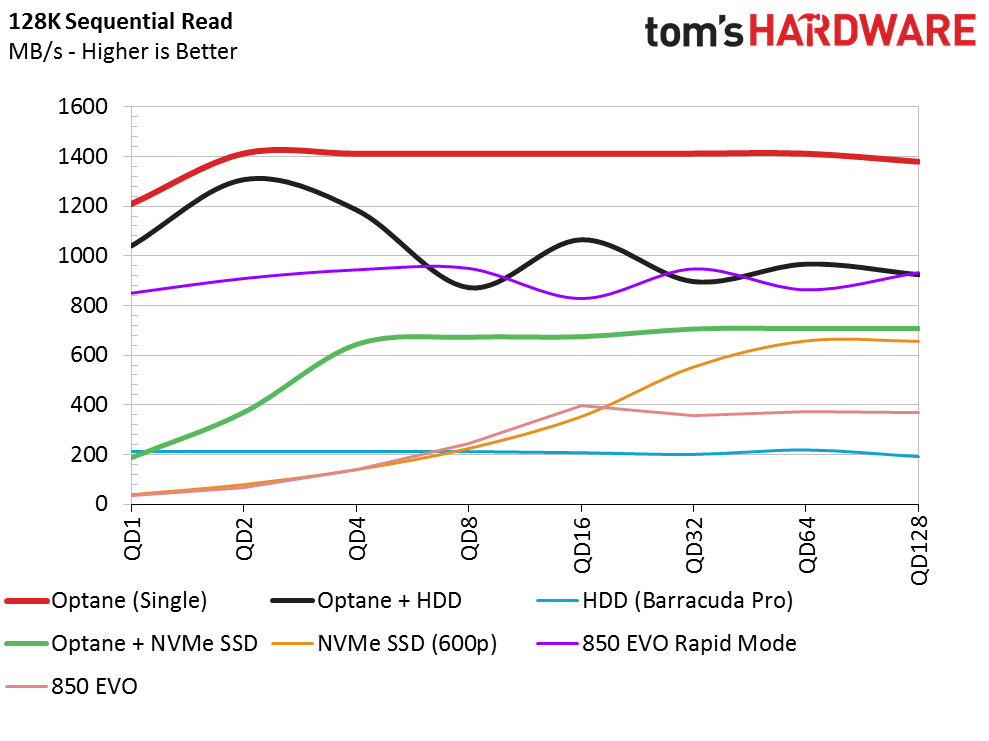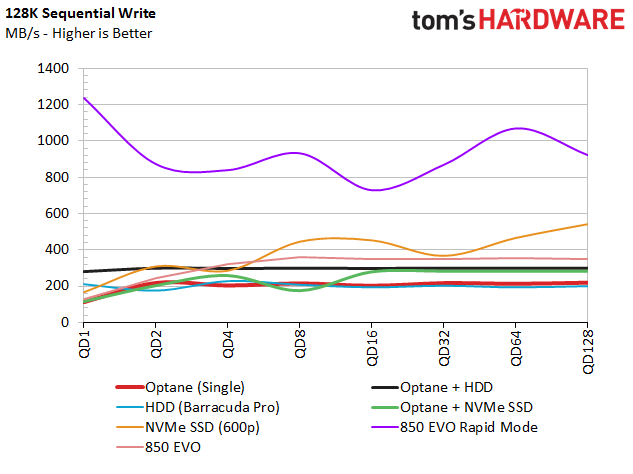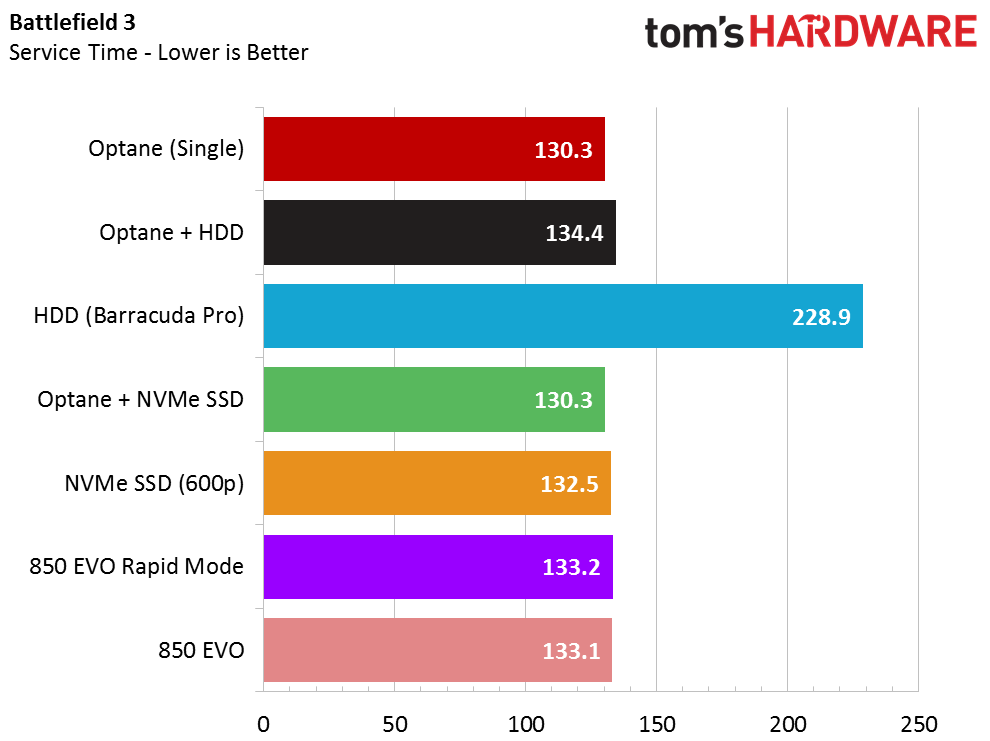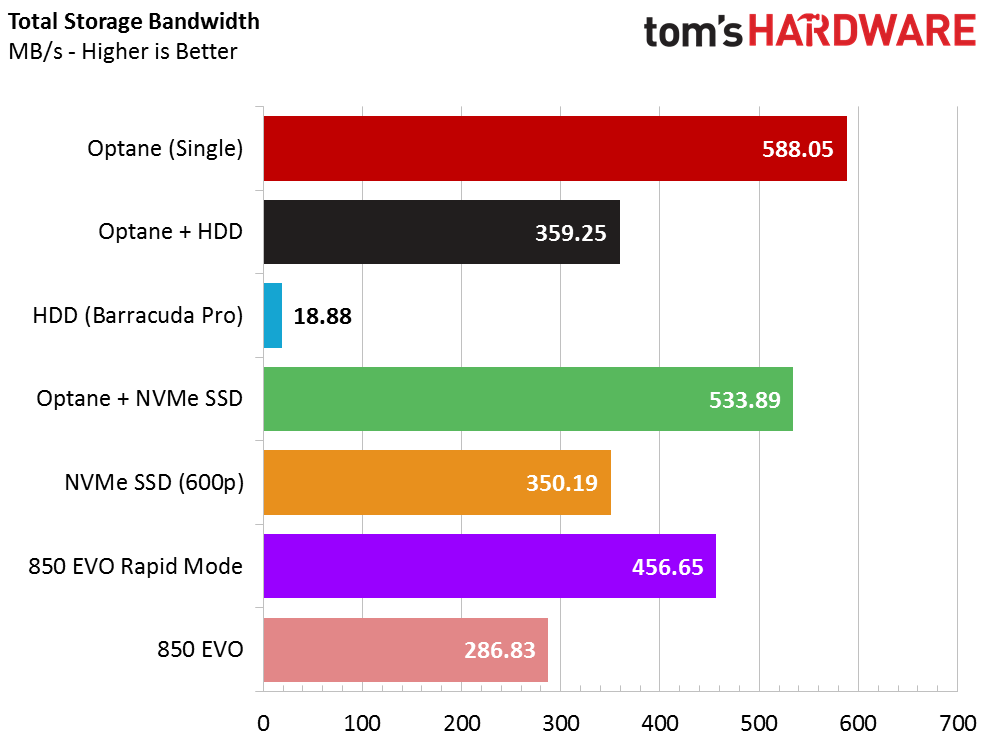Intel Optane 3D XPoint Memory Review
Why you can trust Tom's Hardware
Test Results
Sequential Read Performance
To read about our storage tests in-depth, please check out How We Test HDDs And SSDs. We cover four-corner testing on page six of our How We Test guide.
Before we begin our performance analysis, let's do a quick rundown of the products listed in the charts. "Optane Single" is the Optane Cache SSD running as a secondary volume. This allows us to examine the maximum performance possible from the Optane Memory cache drive. We present the Seagate BarraCuda Pro 10TB both as a single HDD and combined with the Optane Memory SSD (Optane + HDD). This is the only officially supported Optane Memory configuration with the preloaded files in place (and any other optimizations that Intel didn’t disclose).
An Intel 600p 1TB SSD also appears both as a single drive and combined with the Optane Memory drive acting as a cache (Optane + NVMe SSD). This is not an officially supported configuration, but it is possible with the Optane Memory SSD acting as a generic cache device. The Samsung 850 EVO 500GB SSD appears both as an unaccelerated SSD and with Samsung's Rapid Mode software. Rapid Mode is Samsung's free RAM caching software built into its Magician management software. You can use Rapid Mode with several of the company's SSDs.


We would like to reiterate that, except for the Optane (Single) results, we ran the tests with the operating system on the drive. We couldn't fit an operating system and our test software on the solo 32GB Optane volume. Also, we enabled all performance-robbing (but power-saving) C-States during the tests. Most casual computer users are not aware that these BIOS settings have such a profound impact on performance, but you will notice very low performance from the Intel 600p and Samsung 850 EVO products at most queue depths. Finally, we used a large dataset for the synthetic tests to reduce the impact of Optane Memory. A smaller dataset would have resulted in the entire test file being promoted to the cache device. Our test results represent a mix of both cached and uncached performance.
The solo Optane Memory drive delivers 1400 MB/s of sequential read throughput with a single worker. The drive suffers a slight drop off at a queue depth (QD) of 1, but that is most likely due to Windows’ low power settings. The power settings reduce the bandwidth to the drive during light workloads but opens the pipe during increased activity. There is a slight delay for the power state transition, and at these speeds, every microsecond appears in the results. PCI Express seems to take a larger performance hit than SATA with the low-power states enabled.
Pairing the HDD with Optane Storage provides a large performance increase over the bare hard drive. This is the target use case for Optane Memory. Surprisingly, performance is in line with the Samsung 850 EVO running in RAM-powered Rapid Mode at higher queue depths. At low queue depths, there is only a small difference between the solo Optane drive and the Optane Memory with HDD.
The NVMe Intel 600p relies heavily on an internal emulated SLC cache layer in front of the native TLC storage. The C-States and Windows power saving features rob the PCIe drive of performance. Putting the Optane SSD in front of the 600p delivers a larger performance boost that users will see when loading applications.
Get Tom's Hardware's best news and in-depth reviews, straight to your inbox.
Sequential Write Performance


The Rapid-enabled 850 EVO pulls ahead in the sequential write test. Optane Memory with a hard disk drive optimizes the system for increased performance beyond the standard storage settings. When the official software enabled, we managed to achieve a better score than with just the Optane drive writing sequential data on its own.
The 600p with SRT Enhanced cache doesn't receive write data acceleration, but it would in maximum mode. We will explore the option at a later date.
Random Read Performance



Random read performance is the breakaway test for Optane Memory technology. The drive itself can deliver 71,000 IOPS at QD1. That is faster than any SSD ever sold, and that includes expensive SLC products that are no longer available.
In the random read test, it did not matter if we paired the Optane Memory drive with a hard disk or an SSD. The two performance lines are nearly identical. That would change in the event of a cache miss, but Intel did a very good job making the system smart enough to cache hot data even though we used a very large test file.
Random Average Read Latency
We often talk about latency but rarely have the opportunity to show the difference between flash-based storage and disk-based storage. This chart shows the average latency of the random read tests up to QD8. The only line you can make out is the hard disk drive. Flash, and now 3D XPoint-powered Optane, are much faster than spinning disks.
Random Write Performance



Optane Memory turns your hard disk drive into an SSD for random data writes. The cache device just absorbs the writes at high speeds. The data will eventually pass to the physical hard drive during idle time without any user intervention.
Random Write Latency
The random write latency test shows the Seagate Barracuda Pro's performance curve. All the flash-based and accelerated configurations are so much better that we can barely see the latency on the chart.
80 Percent Mixed Sequential Workload
We describe our mixed workload testing in detail here and describe our steady state tests here.
3D XPoint technology delivers incredible mixed random performance. The solo Optane drive delivers right around 800 MB/s, and that is enough to accelerate both flash and spinning disks. The best part is Optane’s ability to increase performance at low queue depths, which is crucial to boosting overall system performance.
80 Percent Mixed Random Workload
The Optane Memory SSD delivers nearly 100,000 write IOPS at QD2 during our mixed random test. The bare hard disk drive is barely even a blip on the chart, but within an Optane Memory array, the spinning disk performs more like a high-performance flash-based drive that can cruise through the workload with ease.
PCMark 8 Real-World Software Performance
For details on our real-world software performance testing, please click here.










The PCMark 8 Storage tests show what Optane's performance equates to during real-world applications. The hard disk drive stands out in all the tests because it takes longer to complete each task. All of the solid-state drives, including the Optane Memory accelerated products, take much less time and show less variance in the time to completion amongst the group of similar products.
Application Storage Bandwidth
The Optane Memory accelerated hard drive provides a larger performance improvement over the accelerated NVMe SSD, but the latter provides an overall higher level of performance.
The solo Optane SSD running as a storage device delivers the best overall performance of the entire group. The performance is promising and leaves us excited for what Intel can do with this new memory technology.
System Testing With BAPCo SYSmark 2014 SE





BAPCo’s SYSmark 2014 SE uses applications from Microsoft, Adobe and others to measure system performance, responsiveness, and power in an automated environment. We use three iterations for each test and enable the power measurement feature. The feature uses a dedicated device to feed the power consumption data back to the system for logging.
In this series, the Optane-only device is absent because we can’t install the operating system and the software on the 32GB drive due to the capacity limitation.
Like the previous series of tests, the hard drive without acceleration suffers lower performance than the accelerated and flash-based solutions. With the hard drive accelerated by Optane Memory, the HDD comes alive and performs more like an SSD. Optane Memory also increased the performance and system responsiveness of the Intel 600p 1TB SSD.
This series also shows the only power measurements we recorded for this review. Optane Memory increases overall system power, but not by a small amount. We expected this result, and not for the obvious reasons. Yes, you are adding another component to the system, and that does require more power, but most of the additional power consumption is from the increased data traffic. The processor, system memory, and other components spend less time waiting for data and more time running the workload. This increases power consumption but allows the task to complete sooner.
MORE: Best SSDs
MORE: How We Test HDDs And SSDs
MORE: All SSD Content

Chris Ramseyer was a senior contributing editor for Tom's Hardware. He tested and reviewed consumer storage.
-
Joe Black Some nice figures, but not quite what I expected from the hype. Not sure if its amazing enough that it warrants a whole exclusive series with special motherboards et al.Reply -
Brian_R170 The performance is better than I expected, but if I'm reading it right, the supported target market consists of desktops with 200-series chipsets and mechanical hard drives. That market just seems way too small. Am I missing something?Reply
Wake me up when the rumored Intel 900p Optane SSD starts sampling in 500GB and larger sizes. -
dstarr3 Reply19605577 said:What about an SHHD like the Seagate with 8gb cache?
This far exceeds the bandwidth of the SATA port you'd plug such a hard drive into, so you'd see no benefit over the SSHDs currently on the market. -
gdmaclew Target market seems a little small (intentionally?).Reply
I know this is early in the game but this has a slight RAMBUS smell to it. I hope I'm wrong.
I'll feel better when Intel at least offers licensing to other platforms (AMD).
-
hannibal In few year the support come to all PC platforms. And if this makes my hdd look like very fast ssd in normal usage... not bad at all.Reply
Am I wrong if the maximum size that the cache support is still 64Gb? Hopefully there will be that size too Sooner than later. Then there would be less cache misses. -
stairmand The problem I have is that I bought hybrid drives before and they were always a bit disappointing. The were mostly good but often crappy, not sure I'd want to tread that path again.Reply -
JamesSneed So if you have a 200-series chip set and a hard drive today this would be a really cheap storage upgrade. Interesting to see it doesn't really matter in real world testing as long as you are not using a spinning hard drive by itself regardless if its an nvme drive or Optane.Reply




